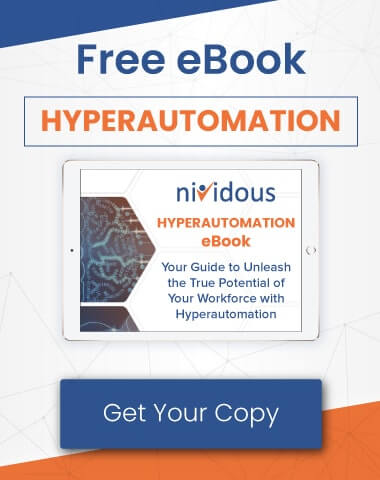There are a number of ways companies can employ automation to meet their speed and accuracy goals in onboarding individuals. Intelligent automation—a type of automation that uses technologies like RPA (Robotic Process Automation), AI, API, and BPM (Business Process Management)—is a key part of end-to-end process automation, which can save businesses personnel, time, and money.
Companies can even use onboarding automation in different types of enterprise relationships:
- Companies large and small can automate employee onboarding
- B2C companies can automate customer onboarding
- B2B companies can automate parts of their client onboarding
In this article, we’ll be focusing exclusively on hiring and training as a continuous automated employee onboarding process. If you run a larger corporation, this is usually the more pressing operational bottleneck. Not only will an efficient process help you onboard employees faster, but when they are onboarded well, employees will achieve more at a faster pace, even within their first year of employment.
For these reasons and more, every business would benefit from onboarding automation. Keep reading to learn more about the steps involved in implementing it, and a simple route to get started.
See how onboarding automation might look at your company.
Talk to Nividous about using our easy-to-implement intelligent automation platform.
3 Steps To Onboarding Automation
An automated onboarding process includes every aspect of onboarding—from job posting and talent searching to hiring and training—to create a smooth and efficient end-to-end flow. Here’s a general overview of how to approach the implementation process:
Step 1: Recognize your areas of need.
Every organization onboards employees differently, but in our experience, most of the root causes of bottlenecks tend to occur in the same areas. If any of the following criteria are true for your company, it’s a good indicator that you would benefit from automation:
- Your onboarding processes use multiple web and distribution applications.
- Your onboarding processes use multiple team members and man hours that could be used elsewhere.
- You need to quickly identify and fill vacant job positions.
- You need a way to quickly upload job postings to different job boards and portals.
- Your process for matching CVs and resumes with job requirements is too slow or inaccurate.
- You need a quicker way of scheduling interviews with prospective employees.
- Your assignment processes—the ones that decide which department new hires are assigned to and which employees they train under—are confusing or disorganized.
- You use Google Workspace, Jira, or other cloud-based project management software to assign your new hires to onboarding tasks.
Step 2: Prepare your organization for onboarding automation.
Next, ensure that your onboarding processes are optimized for automation.
This step is crucial to allow for an efficient transfer to an automated employee onboarding process. Ask yourself the questions below to help prepare, and record your answers:
- How exactly does your current manual process work?
- What software, websites, job boards, training software, or management portals do you use to onboard employees?
- How will your company’s various departments decide what skills they need from new employees?
What is the step-by-step process for onboarding a new employee, from a department communicating needs to a new hire’s completed training?
Step 3: Narrow down onboarding tasks ready for automation.
Once you’ve recognized a need and prepared your processes, it’s time to assess your current hiring and onboarding to figure out the ways automation can assist. Below is a list (that’s by no means comprehensive) of some ways automation can help.
Automation can:
- Exchange onboarding data between project management systems. Many companies use multiple project management systems, necessitating constant exchange of information between them to ensure new hires (and existing employees) are trained at the expected pace. They also often need timely exchange of job requirement data between company systems and various job portals to make accurate job postings. Intelligent automation can quickly transfer data between systems, eliminating the need for cumbersome manual exchange by teams of employees—and saving your employees’ precious time.
- Collect job requirements from different company departments. RPA can use various types of bots to collect relevant data and disperse it throughout your company—and in the case of hiring new team members, RPA bots can make communication for your talent acquisition department a breeze. RPA bots have the ability to collect requirements from department heads, prepare a list, transfer that to the hiring department, and consolidate all information so that your hiring experts know exactly what type of individual they need to search for next.
| NOTE: With this automated task, some new hire skills may still need to be verified by humans. But even for these more complicated verification processes, a comprehensive intelligent automation solution can provide structure: workflow automation can trigger tasks for humans to review new hire skills at a certain time, then record their answers and pass those answers on to RPA bots for the next steps of automation. |
- Create a “hire-to-retire” process for new employees. When a company searches for new hires to complete tasks that can be partially automated, that company can look for candidates with additional automation management skills. In this way, the new hire can complete the needed tasks while supervising the automated portions of the task, becoming an efficient, one-person team. By combining hiring and creative processes above with elements of RPA, API, and AI, intelligent automation can both create new processes and hire people to oversee them.
- Use intelligent document processing. Whether the documents in question are semi-structured, structured, or unstructured, intelligent document processing (IDP) uses various technologies to extract needed data before sending it where you need it to go. These technologies include Computer Vision, Natural Language Processing, Meta Language (ML), and AI.
- Provide visibility into company training portals. Automation technologies can recognize and report on new hires’ (and existing employees’) progress in job training if that training is carried out through a portal, suite of software, or in another digital space. Automated processes can also pinpoint when an employee has not finished training and send them a reminder.
Ready to get started with onboarding automation?
If you’d like to save time, cut out wasteful tasks, and gain better visibility into your new hires’ experiences, Nividous can help you in automating your employee onboarding process.
Our intelligent automation platform is designed to help companies like yours implement automation quickly, easily, and inexpensively. It combines RPA, AI, and business process management to deliver automation solutions tailored for your use case—without the need for data scientists, computer programmers, or lengthy training sessions. Our Nividous Quick Start model is specifically designed to expedite quick adoption of RPA. Working closely with our experienced professional services consultants, you’ll typically have a solution to deploy within three to four weeks.
Want to learn how onboarding automation can help your company?
Schedule a free, customized demo to explore the Nividous intelligent automation platform and how it can improve your onboarding processes.




![The Path Forward for Intelligent Automation [2024 Trends] Blog Feature](https://nividous.com/wp-content/uploads/2024/05/The-Path-Forward-for-Intelligent-Automation-blog-feature-1.webp)
